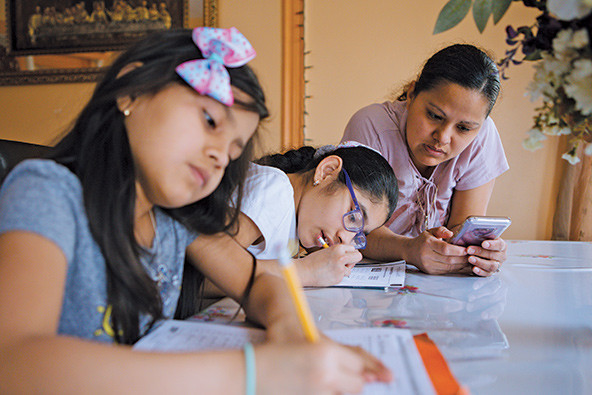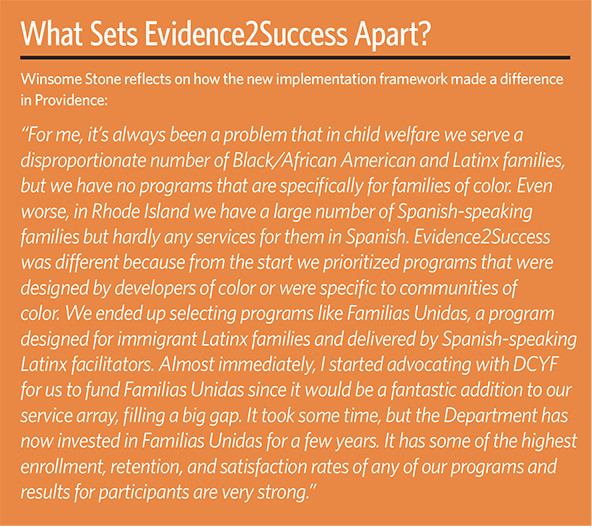 Silvia, a participant in the Familias Unidas program, sits with her two daughters. (Photo by Stephanie Alvarez Ewens)
Silvia, a participant in the Familias Unidas program, sits with her two daughters. (Photo by Stephanie Alvarez Ewens)
When the Children and Youth Cabinet (CYC) of Rhode Island was founded in 2011, its mission was to gather, analyze, and disseminate data and best practices to support Providence’s children and youth. Over time, CYC staff determined that their organization was not sufficiently equipped to deliver what the community told us they wanted: programs designed for communities of color.
Bringing Equity to Implementation

Implementation science—the study of the uptake, scale, and sustainability of social programs—has failed to advance strategies to address equity. This collection of articles reviews case studies and articulates lessons for incorporating the knowledge and leadership of marginalized communities into the policies and practices intended to serve them. Sponsored by the Anne E. Casey Foundation
-
Equity Is Fundamental to Implementation Science
-
Trust the People
-
Youth Leadership in Action
-
Community Takes the Wheel
-
Equity in Implementation Science Is Long Overdue
-
Listening to Black Parents
-
Faith-Based Organizations as Leaders of Implementation
-
Community-Defined Evidence as a Framework for Equitable Implementation
-
Community-Driven Health Solutions on Chicago’s South Side
-
Equitable Implementation at Work
Today, CYC is a very different kind of organization—it’s an intermediary that invests more than $2 million annually in programs that support behavioral health outcomes in Rhode Island’s urban communities. But the journey from a collective-impact coalition to a responsive intermediary that embraces equitable implementation took time. It required changing staffing practices, installing community residents in leadership roles, and restructuring its operating status to become what we call a “nimble” intermediary that pursues programs, funding, and implementation according to what residents say they need, and in a way that is designed to work for them. CYC also had to define and embrace what became the four cornerstones of its approach to equitable implementation: engagement, agency, relevance, and investment.
Longtime Providence residents like Winsome Stone have played a pivotal role in this journey. Winsome is an executive at the Rhode Island Department of Children Youth and Families (DCYF), the state child welfare system. She is also a mother and has lived in the same community for many years. As the implementation field faces hard questions about relevance and design of evidence-based practices and programs for communities of color, the vision and expertise of community members like Winsome are an integral part of the solution.
“We need services that reflect families’ own experiences and we need organizations that actually engage with residents,” Winsome says. “We can’t just say ‘equity’ over and over and expect results.”
CYC now invests more than $2 million annually in a prevention portfolio that includes three evidence-based programs focused on preventing problems for young people before they develop: Familias Unidas, Strong African American Families, and Cognitive Behavioral Intervention for Trauma in Schools (CBITS). Each of these programs has been designed, disseminated, or adapted by people of color for specific communities of color. The workforce delivering these programs is composed exclusively of clinicians, artists, and facilitators of color who share the experiences and backgrounds of program participants. This is one of the ways to ensure that equity takes priority and the evidence gathered is relevant to our residents.
Engagement: From Tokenism to Meaningful Partnership
CYC became the national pilot partner for Evidence2Success in 2012. Developed by the Annie E. Casey Foundation, Evidence2Success is a five-phase planning and implementation framework for improving the well-being and development of children and youth, as well as reducing racial disparities. The framework relies on the expertise, authority, and decision-making of residents as a way for communities and public partners to work together. The goal is to help public system leaders and community residents gather data on the needs and strengths of local youth, use the data to set priorities to improve well-being for young people, and shift public funding to address those needs with evidence-based programs.
Evidence2Success is guided by principles of evidence, prevention science, authentic community engagement, and racial equity to dismantle barriers for children and families of color, and to improve public systems. As Winsome notes, the phases of Evidence2Success emphasize adapting to community history and context, creating customized ways for residents to participate authentically, establishing clear roles for key constituents, and building trust with the community.
“When I was first asked to participate in Evidence2Success as a representative of DCYF, it felt like they were ‘checking boxes’ because I’m Black, I live in South Providence, and I’m a mom,” Winsome says. “In my experience, a lot of state agencies do that; they want to believe they’re focusing on equity but in reality, it’s more like tokenism.” But Winsome’s faith in the program grew over time: “It became clear that there was a place for my voice to be heard, a process that was genuinely inclusive of residents, and a role for me to play as an advocate for families. I was able to use my experience to make sure equity was always up front and ensure that evidence is also relevant to our residents.”
When adopting the Evidence2Success framework, CYC needed to redefine old notions of what it meant to engage residents. In initial interview responses to evaluators, residents said that CYC’s staff were not connected enough to the racially diverse neighborhoods where the pilot was taking place.1 It became clear that effectively engaging residents was not just a one-time or even occasional activity, but an ongoing process that required continuous two-way communication, defining and supporting community roles, and power sharing. CYC had to redesign its business model and make sure staff delivering programs shared the culture and experiences of the communities where they were working.

Agency: Setting Priorities and Making Decisions
Until recently, equity in implementation has often been an add-on or afterthought with intangible strategies that lacked authenticity. Through experience and adjusting our practices, CYC has learned that activities explicitly designed to drive equity need to happen from the earliest stages of program implementation, establishing that residents involved in the process have tangible agency and power.
“Early on in Evidence2Success, there was a ton of skepticism with residents asking, ‘How do we know you’re going to deliver for us this time?’” Winsome says. “Throughout this process I saw that residents were asked what their priorities were for their own families, that programs that are culturally relevant were selected with residents, that the CYC actively secured resources to fund and scale those programs, and that the selected programs have all been implemented with positive results for children, youth, and families. To me, this shows that when you lead with equity, you establish trust with community and that trust is strengthened when you do what you say.”
Consensus building and trust quickly became bedrocks of meaningful progress. CYC’s commitments to these two goals were first put to the test during joint priority setting—a key part of Evidence2Success that serves to establish what residents want for their children, young people, and families. To begin, CYC led a series of conversations with groups of residents in community settings. Participants looked at answers to a survey taken by more than 5,000 local middle- and high-school students that asked about the students’ experiences and welfare in five areas: behavior, education, emotional well-being, positive relationships, and physical health. Participants used these data to determine their top well-being outcomes for children and youth in the community. Although some behavioral health indicators were significantly worse than national averages, they weren’t necessarily the top priority of residents, who chose to focus instead on addressing anxiety, depression, delinquency, chronic absenteeism from school, and difficulties in emotional regulation. This revelation was a seismic step in CYC’s learning, the shift from “we know what’s best for you” to “you know what’s best for you.”
The next milestone was selecting evidence-based programs to improve the priority outcomes. To prepare for this, a committee that included residents researched dozens of programs, interviewed people in other communities who had implemented the programs, and reached out to program developers to ask questions. The committee asked about developers’ backgrounds, whether programs were designed for communities of color, and if they had documented effective results for diverse populations. Using a set of filters that focused heavily on how programs might fit with our local community, the committee recommended a set of 10 programs, from which up to 4 could be selected.
We then held another meeting where residents, representatives of public systems, and community partners came together to select a portfolio of prevention programs that were relevant to their community and experiences. Residents presented each of the programs under consideration and shared the research on how each program might fit the community’s needs. During the meeting, a city councilor pointed out that it was unacceptable that a city with a student population that is 60 percent Latinx had few, if any, programs that reflected the experience of its Latinx immigrant population. This led to the selection of Familias Unidas, a program specifically designed by a Latinx team from the University of Miami for immigrant Hispanic youth and their families.

During moments like these, decision-making authority shifted to the community. With residents making their priorities and preferred programs clear, CYC now had an equally clear responsibility to deliver on the commitments it had made to secure investment, implement programs, and share results. At this point, CYC’s structure began to shift from a broad volunteer collective impact coalition to an intermediary with dedicated paid staff in order to deliver on those commitments. In addition, CYC created clear ways for residents to get involved with its decision-making bodies and began to bring together community members, including youth, to solicit their guidance and expertise.
Relevance: Redefining Expertise and Considering Cultural Fit
While implementation science prizes traditional academic or professional expertise, few variables in implementation are more important in predicting successful uptake, early success, scaling, and long-term sustainability than alignment with and a deep understanding of the community and local context. In Providence, implementation teams power the successful implementation of evidence-based programs, ensuring that programs actually produce the intended outcomes for children and families. Implementation team members are primarily residents who have special expertise about programs, implementation practice, continuous quality improvement cycles, system-change methods, and community experience and context. CYC convenes a discrete implementation team meeting for each program every month, where participants review qualitative and quantitative data, share relevant context for the results they review, and address problems as they emerge. These meetings guide the changes CYC needs to make to ensure programs are effective and relevant to community members.
Winsome volunteered for the first CBITS implementation team. After she and others noticed at the team’s early meetings that young people were not engaging in the group, the team began to design and test what is now a highly effective adaptation of CBITS—bringing performance artists of color into the groups to increase engagement and relevance. The artists use their art to share stories of their own trauma and act out strategies to better cope with negative feelings. Pairing a mental health clinician of color with a performance artist enables students to feel more comfortable sharing their own traumatic experiences and more willing to use the tools and strategies presented.
“Pretty quickly we learned that these youth didn’t feel like the group facilitator, who was older and white, could really relate to their experience and trauma,” Winsome says. “Once we ensured group leaders were clinicians of color alongside young adults with lived experience, engagement and outcomes improved significantly.” This adaptation in response to what young people told us has increased engagement and attendance in the program and reduced symptoms of post-traumatic stress disorder among participants.
CYC did a lot of internal work to support communities in their implementation efforts. Each evidence-based program is led by a CYC project manager who also convenes and leads the implementation team. The project managers also coordinate with public partners, collect and analyze program data, manage outcomes, and facilitate training, among other activities. CYC’s programmatic workforce is now composed entirely of BIPOC, and we, as leaders of the program, made the commitment two years ago to hire only BIPOC project managers.
Investment: Supporting Long-Term Commitments
Delivering large-scale results for communities requires ongoing investment from the public systems that serve those communities, yet these systems and the communities they serve often do not share common priorities. When CYC finished its program selection, residents had delivered a mandate not only to implement their recommended programs but to raise and secure investments to expand those programs.
Public education, health, and child welfare offices initially made small financial commitments. CYC focused on building a strategy that would tap diverse sources of funds to improve outcomes for large groups of children, youth, and families. The explicit focus on equity and on culturally specific programs has enabled CYC to grow existing investments and unlock new funding. In fact, CYC received its first sizable award, from the Rhode Island Department of Health, to address behavioral health inequities. CYC educated public officials and leaders in the fields of child welfare, education, and behavioral health about gaps in the services they offered for communities of color and engaged in discussions on how to fill those gaps. As a result, Rhode Island public systems have invested more in services that are designed for and valued by these communities. CYC’s evolution into a fiscal intermediary has enabled the organization to take an equity-first approach to implementation and to gain more flexibility to raise funds that will advance the community’s strategic priorities.
Looking Ahead
CYC’s journey isn’t finished inside or outside our organizational walls. While we have successfully diversified our administrative and project management team, we need to build meaningful opportunities and pipelines to join senior leadership, and we need to codify policies and practices that support this goal. We will stay focused on engagement, agency, relevance, and investment in the following ways:
- Engagement: CYC’s resident advisory board, currently composed exclusively of Latinx residents, provides ongoing consultation on program implementation—facilitating community conversations about behavioral health outcomes—and will be generating research questions to further this body of work. CYC also supports the work of a youth-organizing group that delivers a monthly podcast on a range of relevant topics. In the next year, this youth-led team will discuss behavioral health access and youth trauma, in addition to advising on CYC’s initial implementation of Act and Adapt, which is an evidence-based program specifically designed for students of color experiencing acute depression.
- Agency: The resident advisory board and the podcast team will make decisions and recommendations to advance our work in the coming year, along with the day-to-day and week-to-week decisions that are made by resident clinicians, artists, and facilitators in implementation team meetings and programmatic settings.
- Relevance: CYC will add Act and Adapt to its suite of programs and will continue to expand its BIPOC workforce of facilitators, artists, and clinicians.
- Investment: CYC will continue to align all the investments it makes and seeks with residents’ chosen priorities and programs, to expand investments in its BIPOC workforce to match the expansion of programs, and increase investments in resident advisory and youth organizing projects through active pursuit of new federal, state, and philanthropic dollars as well as public service-delivery contracts.
While the work in Providence is not yet complete, CYC is on the road to lasting, systemic, equitable change, and has made the critical transition from frameworks to action and results. In doing so, we have been able to redesign our work to break through barriers that have denied communities access to evidence and positive results for far too long.
Support SSIR’s coverage of cross-sector solutions to global challenges.
Help us further the reach of innovative ideas. Donate today.
Read more stories by Winsome Stone, Matthew Billings & Rebecca Boxx.

